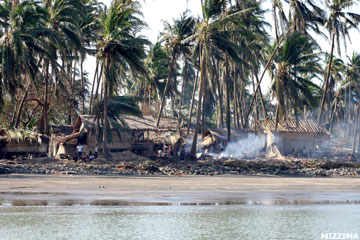Following donations already made by Australia, Japan, Britain and Denmark, the United States’ embassy in Rangoon is to tender a US$3 million donation for Cyclone Giri victims in Arakan State through social and relief organisations ...
Chiang Mai (Mizzima) – Following donations already made by Australia, Japan, Britain and Denmark, the United States’ embassy in Rangoon is to tender a US$3 million donation for Cyclone Giri victims in Arakan State through social and relief organisations, Arakan League for Democracy (ALD) party leader Aye Tha Aung said.
 But many more donors were still needed to cope with storm victims’ needs, he said.
But many more donors were still needed to cope with storm victims’ needs, he said.
“I found people were suffering from diarrhoea. They have not yet got enough houses and makeshift shelters as the winter season is drawing very close. When the winter comes, the health situation of the victims will worsen so we need to give them enough materials for shelters,” he added.
Giri hit the Arakanese coast on October 22, flattening villages in the worst-hit townships of Myebon, Pauktaw, Kyaukphyu and Manaung with winds gusting up to 160 mph (257 km/h). Major livelihoods were also severely curtailed. Fisherman reportedly lost thousands of trawlers and shrimp farmers’ ponds were swamped in storm surges that in some areas reached as high as 12 feet (3.7 metres).
Storm victims in the worst-hit Myebon Township were now facing drinking-water shortages and suffering from diarrhoea and eye infections, an aid worker from a group carrying out relief operations told Mizzima.
Australia had already donated US$3 million in assistance to help affected communities and families recover from this disaster and provide essential food, shelter, clean water and sanitation, the United Nations Office for the Co-ordination of Humanitarian Affairs (Ocha) said in its situation report released on Wednesday.
“An immediate US$200,000 was provided last month through the Australian Red Cross, and the further US$2.8 million will be delivered through the United Nations World Food Programme (WFP) and Australian non-governmental organisations, Care Australia, Save the Children Fund, Oxfam Australia, Burnet Institute and the Australian Red Cross,” Ocha said its ninth situation report on the storm.
The US had also donated US$100,000 to victims of the storm in October for building shelters through its Rangoon embassy, prior to its recent promise of US$3 million.
INGOs including the WFP, NGOs and social aid groups were also providing assistance in food, shelter, clothing and health care in the other hard-hit townships.
The military regime was rebuilding government offices and school buildings, a representative of the Rangoon office of Unicef said, adding that more than 150 schools were damaged in the storm.
The Ocha situation report said UN and NGO aid “clusters” agreed, and had identified funding needs close to US$53 million including emergency and early recovery phases. Out of these, donors had already pledged up to US$18 million.
Meanwhile, aid groups said that while the junta-backed Union Solidarity and Development Party had distributed rice to storm victims before the Burma’s general election on November 7, they were nowhere to be seen now.
The junta government reported that at least 45 people were dead or missing to date, while 101,923 remain homeless and at least 20,380 houses were destroyed, with a total of at least 260,000 people (52,000 households) affected, Ocha reported.
About 17,500 acres (70 square kilometres) of agricultural land and nearly 50,000 acres of aquaculture ponds were also destroyed. Transportation to the area remains challenging, as roads and bridges collapsed and were washed away. A large part of the affected areas can only be reached by boat, says the UN body’s report.
Mizzima reported early this month that Britain had pledged US$700,000 in relief aid to victims of the Category Four Storm. Ocha’s report yesterday also said that Japan would provide emergency assistance amounting to US$500,000 through the WFP to the affected population.



